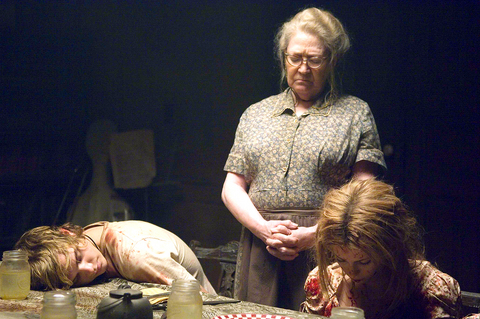There's been some local fuss over the violence in this, the latest retread of Tobe Hooper's The Texas Chain Saw Massacre (1974), which opens in Taiwan today in tandem with the US. But the real problem is that The Texas Chainsaw Massacre: The Beginning isn't very scary. It's more violent than the 2003 remake to which it is a prequel, but a trailer for The Grudge 2 that preceded the screening was much more frightening, which isn't a good sign.
Director Jonathan Liebesman lets you know from the first frames how he will proceed: extreme close-ups, overbearing music and thumping noises. And that's pretty much how it stays — at the expense of atmosphere and intensity. Liebesman seems to be aiming for viewer claustrophobia, but he serves up disorientation and tedium instead.
He also delivers the shock moment when you most expect it — every single time. And by the halfway mark, there have been so many crunching blows to various skulls by fist, gun and other objects that you begin to wonder if the good ol' saw isn't being upstaged.

PHOTO COURTESY OF APPLAUSE
It's 1969. Vietnam vet Eric (Matthew Bomer) and his brother Dean (Taylor Handley) and their girlfriends Chrissie (Jordana Brewster) and Bailey (Diora Baird) are driving through Texas as Dean prepares to dodge the draft. When Sheriff Hoyt (R. Lee Ermey) turns up at the site of their car accident, he doesn't offer much emotional support. He's after fresh meat for his family.
Imprisoned in Hoyt's home, our insipid heroes are brutalized and meet the dreaded Leatherface (Andrew Bryniarski) and his kooky family, but not before the viewer wonders how the real sheriff could go missing without state authorities swarming the area.
Ermey is a class act. This actor's military background once again serves him brilliantly as he gives these less-than-convincing children of the 60s a real thrashing.
Leatherface, however, is another story. Unlike Tobe Hooper's films, in which the ex-abattoir worker's retarded behavior is cause for horror and humor, here he lumbers around, largely out of frame and with little personality.
On its own terms, The Texas Chainsaw Massacre: The Beginning may impress younger audiences who haven't seen the originals. But those who have will long for the intensity of the dinner table sequence in which poor Marilyn Burns suffered so much, or the sick vaudeville of Leatherface romancing a female disc jockey with his trusty tool. Here, a similar dinner sequence seems to have no idea what it's trying to do and, criminally, gives a lame crowd pleaser punchline to one of the captives.
The American MPAA ratings board allegedly demanded more than a dozen cuts for the film to secure an R rating — though in the modern era such cuts are integral to marketing “unrated” DVD releases. So, no big deal. Whatever you miss you'll see at home, one way or another.
But it seems Taiwan's censors also had a piece of the R-rated version in order that it could screen with a restricted rating here. Thankfully, they don't seem to have used a chainsaw. Only two scenes have obvious jumps in the soundtrack: a skinning where we learn how Leatherface got his leather, and some impromptu chainsaw surgery on a shotgun victim. But fans need not lose heart. What remains in the chainsaw department is intense — if brief. If only the rest of the film were so compelling.

May 11 to May 18 The original Taichung Railway Station was long thought to have been completely razed. Opening on May 15, 1905, the one-story wooden structure soon outgrew its purpose and was replaced in 1917 by a grandiose, Western-style station. During construction on the third-generation station in 2017, workers discovered the service pit for the original station’s locomotive depot. A year later, a small wooden building on site was determined by historians to be the first stationmaster’s office, built around 1908. With these findings, the Taichung Railway Station Cultural Park now boasts that it has

The latest Formosa poll released at the end of last month shows confidence in President William Lai (賴清德) plunged 8.1 percent, while satisfaction with the Lai administration fared worse with a drop of 8.5 percent. Those lacking confidence in Lai jumped by 6 percent and dissatisfaction in his administration spiked up 6.7 percent. Confidence in Lai is still strong at 48.6 percent, compared to 43 percent lacking confidence — but this is his worst result overall since he took office. For the first time, dissatisfaction with his administration surpassed satisfaction, 47.3 to 47.1 percent. Though statistically a tie, for most

Six weeks before I embarked on a research mission in Kyoto, I was sitting alone at a bar counter in Melbourne. Next to me, a woman was bragging loudly to a friend: She, too, was heading to Kyoto, I quickly discerned. Except her trip was in four months. And she’d just pulled an all-nighter booking restaurant reservations. As I snooped on the conversation, I broke out in a sweat, panicking because I’d yet to secure a single table. Then I remembered: Eating well in Japan is absolutely not something to lose sleep over. It’s true that the best-known institutions book up faster

In February of this year the Taipei Times reported on the visit of Lienchiang County Commissioner Wang Chung-ming (王忠銘) of the Chinese Nationalist Party (KMT) and a delegation to a lantern festival in Fuzhou’s Mawei District in Fujian Province. “Today, Mawei and Matsu jointly marked the lantern festival,” Wang was quoted as saying, adding that both sides “being of one people,” is a cause for joy. Wang was passing around a common claim of officials of the People’s Republic of China (PRC) and the PRC’s allies and supporters in Taiwan — KMT and the Taiwan People’s Party — and elsewhere: Taiwan and